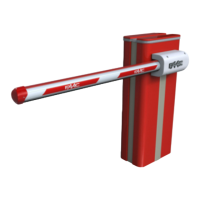Fig. 3
B680H 13 732719 - Rev.D
FSW-CL
FSW-OPEN
J6
DL1 DL2
2Easy BUS
21
Translation of the original instructions
ENGLISH
5.3 BUS accessories menu
The E680 board is designed to connect up to 8 pairs of BUS photocells.
For the bus devices connected to the E680 board to be detected and
managed by it, they must be stored on the board. To do this, proceed
as follows:
• cut off power from the board.
• install and program the accessories using the desired address,
depending on the function you wish to use (as described in
paragraph 4.1.2)
• power up the board.
• access BASIC programming, as described in paragraph 5.1
• once programming step
bu is reached, no, will be displayed,
indicating that here are no stored bus devices.
• to perform entry, simultaneously press and hold the + and - buttons
for at least 5 seconds (during this time, the writing
no will flash)
• once the procedure is completed,
Y will appear as confirmation.
• when + and - are released, the display will show the current status
of the BUS devices, or
no again, if there are no connected BUS
devices.
The following image (Fig. 3) shows the correspondence of the various
display segments to the different types of BUS devices that can be
connected to the system:
FSW CL: BUS photocells placed to protect the gate
closing area
OPEN: BUS photocells used as OPEN pulse generators
From the display of the status of the BUS devices, pressing the + key
enables the types of BUS devices present to be verified.
For example, the following photograph shows safety devices present
during closing and a pair of photocells functioning as open pulse:
For the automated system to operate correctly, the status
of the segments of the left-hand digit must correspond
to the automated system at rest and without pulse
generators or or safeties engaged.
When the CLOSE photocells are engaged, the bottom
segments will go on, as shown in the image to the side.
If the pair of OPEN pulse generator photocells is engaged,
the display will show the configuration of segments
shown in the image on the side of the page, in which the
corresponding vertical segment is on, and will remain like
this until the photocells are disengaged.
If involved, the pair of OPEN pulse generator photocells
commands opening of the automated system and
prevents it from closing until it is disengaged, like a
normal OPEN pulse received through terminal board J1
(terminal 3).
The BUS communication system uses a self-diagnostic function able
to provide connection error signals or BUS accessories configuration
error signal.
The display will show a flashing
cc if there is a
short circuit along the BUS line, as shown in the
figure. To solve the problem it is necessary to
carefully verify all the connections made.
The display will show a flashing
Er as shown in
the image on the side of the page, should more
than one pair of photocells have the same adress
and in case of a calling or failsafe error. Ensure
that the settings are correct, with reference to the
indications given in paragraph 4.1.2
The status of the BUS and related input signals can also be seen
by analysing the two LEDs DL1 (red) and DL2 (green), which make
it possible to immediately verify if BUS communication is active or if
there is an error, and if there are any active inputs or not. The status
The LED states refer to the tables on the following page.
Bus status (always on)

